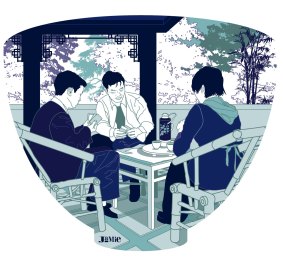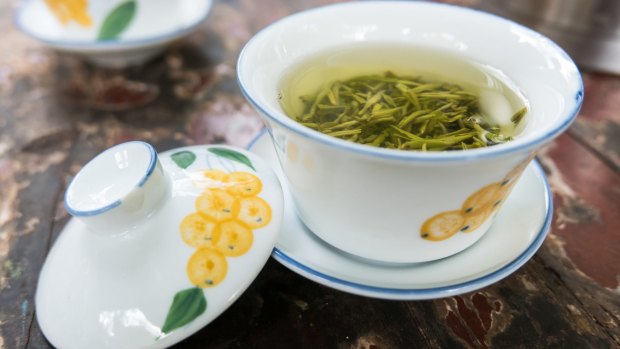This was published 1 year ago
Sichuan teahouses, China: How to best experience this famous tradition

Illustration: Jamie Brown
Sichuan Province has long been famous for teahouses, and a resurgence of teahouse culture in recent years has made them popular all over again. Nothing better captures the laidback lifestyle of this subtropical province, and especially of its capital Chengdu, than an afternoon spent slurping tea and letting the hectic clamour of the rest of China pass you by.
The most atmospheric teahouses are in parks or attached to Buddhist monasteries. Here pensioners gossip, play mah-jong and admire their songbirds, hung in cages on overhead branches. Office workers from shiny skyscrapers collapse into bamboo chairs during their lunchbreaks for an hour in a slower-paced world.
Abandon your sightseeing duties. Pick a table, get your melon seeds ready, order jasmine tea and let a cloudy, humid, lazy Sichuan summer afternoon drift by as the breeze sighs through tall bamboo and red lanterns sway in the trees. Give in to the rhythm of the rise and fall of happy chatter and teacups clicking on saucers.

Tea at a Sichuan teahouse is something to savour.Credit: iStock
The tea usually arrives in sachets with an accompanying Thermos of hot water. Use the lid of your teacup to keep the tea warm, and to strain any tea leaves that float to the surface. You'll want to keep topping up your water so as to avoid the bitter taste from the leaves at the bottom of the cup.
You can make your tea last all afternoon and have no obligation to move on. Traditional accompaniments are boiled peanuts and pumpkin seeds. Some teahouses will serve simple bowls of noodles. Fancy contemporary incarnations of the teahouse – often influenced by Taiwanese or Japanese teahouse culture – provide dim-sum like nibbles accompanied by oolong tea in elegant porcelain cups.
The best Sichuan teahouses are however traditional, low-cost, no-frills places where rickety chairs are scattered beneath bamboo groves. Such teahouses aren't posh, quiet places. They're social spaces where locals go for conversation and card playing.
There's always something to distract your attention: women practising fan dancing and martial arts in the surrounding shrubbery, the polite ritual of dating-club meetings, ear pickers conducting their age-old profession with feathered probes, old men playing Chinese chess. In the evenings, some teahouses feature puppet shows, music or Sichuan opera.
If you want quiet then pick a rainy day, when teahouses in parks are delightfully relaxing. You can sit under the upturned eaves of a pavilion, listen to rainwater gurgling down dragon-shaped drainpipes, and compose a haiku about raindrops and frogs.
Sign up for the Traveller Deals newsletter
Get exclusive travel deals delivered straight to your inbox. Sign up now.